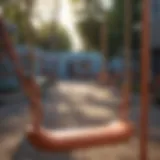Mastering the Installation of String Lights with Wire
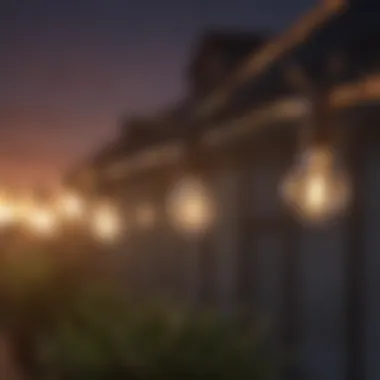

Overview of Topic
Hanging string lights is more than just a chic home enhancement; it's a dance between practicality and artistry. This practice transforms spaces into warm, inviting atmospheres perfect for gatherings or solitary moments of reflection. The process involves specific techniques and considerations, especially when using wire to secure those twinkly delights.
In the home improvement industry, the art of installing string lights is significant for several reasons. It’s a relatively low-cost upgrade that yields high returns in terms of aesthetic value and ambiance. Moreover, in recent years, homeowners have become increasingly aware of the potential that creative lighting has to enhance not only outdoor patios but also indoor spaces.
Importance of the Topic
Hanging string lights effectively can make a dull environment feel vibrant and alive. It brings stories from the outdoors into the comfort of your home, making every gathering a little more magical. But beyond the glow, understanding the science behind the installation is crucial for safety and longevity. Neglecting vital installation aspects can lead to hazards, such as electrical malfunctions or even unsightly sagging wires. Therefore, getting well-acquainted with the tools, techniques, and design principles becomes paramount for any homeowner.
Common Challenges and Solutions
Hanging string lights isn’t all sunshine and rainbows. Homeowners often encounter a few hiccups along the way. Here are some common difficulties along with practical solutions:
- Challenge: Wrong placement and spacing
If you tend to misjudge, the results can look messy rather than magical. - Challenge: Electrical complications
Issues like shorts or blown fuses can send your plans up in smoke. - Challenge: Lack of creativity in design
Your lights may end up looking about as interesting as a wet dish rag if not arranged thoughtfully.
- Solution: Measure your space before you begin. Use painter’s tape to visually map out where you’d like the string lights to hang.
- Solution: Always use outdoor-rated lights and check for frayed wires. A simple voltage tester can help ensure everything is up to par before you plug in.
- Solution: Research different layouts online or use platforms like Pinterest for inspiration. Consider creating patterns, shapes, or themes that enhance the existing architecture of your space.
"Lighting is not just about light itself, but about elevating the spaces we dwell in."
Product Recommendations
When shopping around, it's vital to choose reliable products that provide both longevity and style. Let's delve deeper into a few notable offerings.
- Philips Hue Outdoor Lightstrip
Offers customizable colors and app control, allowing you to adjust the ambience from your smartphone. - Brightech Ambience Pro
This option features shatterproof bulbs, perfect for outdoor use, and includes energy-efficient LED technology. - Twinkle Star String Lights
Known for their versatility, these lights are ideal for creating whimsical designs both indoors and outdoors, with various length options.
Each of these products boasts unique benefits ranging from aesthetic appeal to added functionality. Intrigued homeowners should consider how these features align with their personal needs and desires.
Step-by-Step Guides
Once you've chosen the right products, the next step is to implement them seamlessly. Here's a clear breakdown to guide you through the installation process:
- Gather Tools
Before you start, make sure you have all necessary tools on hand. You’ll need wire, clips, a level, and a ladder, along with safety gear like gloves. - Plan Your Layout
Sketch a rough idea of how you want your lights arranged. Consider where power sources are located for access to electric outlets. - Secure Your Wire
Attach wire along the planned layout, using clips every few feet to keep everything tight and tidy. This prevents drooping and creates a clean appearance. - Hang the Lights
String the lights along the wire and plug everything in. Take your time here; rushing can lead to awkward placements. - Test the Setup
Once everything is in place, turn on the lights before finalizing. Make any adjustments as necessary to achieve your desired look.
Each step plays an integral part in ensuring a visually stunning and functional outcome. When done correctly, the result will be an enchanting environment that’s both inviting and stylish.
Prelude to String Lighting
String lighting, often viewed as mere decor, holds the power to transform any space into a showcase of warmth and ambiance. Whether you're gearing up for a cozy family gathering or looking to elevate the aesthetics of your backyard party, understanding the fundamentals of string lights can significantly enhance your environment.
Understanding String Lights
At first glance, string lights may seem like simple bulbs strung together, but there's more to them than meets the eye. These versatile fixtures come in various shapes, sizes, and styles, each tailored for different atmospheres. When you delve deeper, you find that they can brighten spots both indoors and outdoors, create focal points, and even highlight architectural features of your home.
It's vital to know the difference between types of string lights. For instance, some are specifically designed for outdoor use, packed with weatherproof features that withstand the elements. Think about how solar-powered string lights can cut down on energy bills, or fairy lights that add a touch of magic to an indoor space. The material of the wire and the bulb type, such as LED or incandescent, also play a key role in the light's performance and energy consumption.
The Versatility of String Lighting
The charm of string lights is their remarkable adaptability. Picture this: you can use them to wrap around trees, drape them along fences, or even hang them high above a patio, creating an enchanting canopy. This versatility extends beyond placement; string lights can be used to set a mood for almost any occasion—softening elements for a romantic dinner or ramping up the excitement for a celebration.
In terms of decoration, these lights allow for creativity galore. You could arrange them in geometric shapes, create heart designs, or even spell out a phrase that speaks to your family ideals. For households with an artistic flair, this illuminative medium can spark exceptional DIY projects, resulting in personal touches that reflect your unique style.
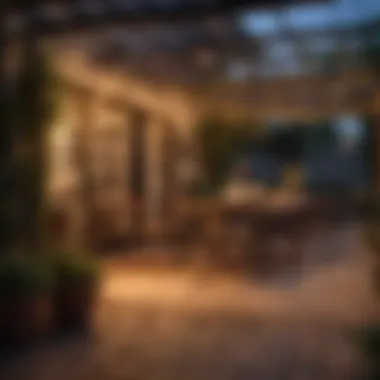

To conclude this opening segment, string lighting isn't just about hanging a few bulbs; it's about utilizing their multifaceted nature to curate an environment that resonates with your personality and purpose. It's the difference between walking into an average room and stepping into a space that feels alive and inviting.
"Lighting is not just about illumination; it's about creating an experience that lingers in the memory long after the last light goes out."
As we move forward, you'll discover how to effectively plan your installation to maximize the potential of string lighting in your home.
Planning Your Installation
Planning your installation is a key element that lays the groundwork for transforming your space with string lights. It’s not just about hanging a few bulbs; it requires a thoughtful approach to ensure the outcome is both practical and visually stunning. By taking the time to plan, you can prevent common headaches such as improper spacing, insufficient lighting, or even safety hazards. So, let’s break down the essential steps to consider in the planning phase.
Selecting the Right Location
When it comes to selecting the right location for your string lights, you want to think about function and aesthetics. Consider how you use your space. For outdoor areas, like patios or backyards, look for places where the lights can enhance gatherings or provide ambient lighting for relaxation. Avoid areas near trees or shrubs that may obstruct the light's path or cause tangled wires.
For indoor installations, mark spots that can highlight focal points, such as artwork, bookcases, or event areas like dining setups. And if you have high ceilings, hanging lights can create a cozy feel, but be cautious with placement to prevent a cluttered look.
- Survey Area: Walk around and visualize different placements.
- Distance Considerations: Assess how far lights need to stretch.
- Height Matters: Consider headroom; keep lights at a safe height to avoid accidents.
Designing Your Layout
Once you’ve pinpointed the location, it’s time to design your layout. Here, creativity meets practicality. Think about the design language you want to speak. Do you prefer uniform rows, or would a free-form, whimsical approach suit your style better? Sketching or using string to represent your lights can make this process easier.
You can opt for these popular configurations:
- Straight Lines: Ideal for an organized and clean look.
- Overlapping Shapes: Circles or loops can create a playful atmosphere.
- Layered Designs: For a more complex arrangement that adds visual interest.
Try not to overthink it; let your instincts guide you. Visual harmony should remain your priority, ensuring the lights complement, rather than clash with, the existing decor.
Calculating Light Requirements
Having a beautiful layout is half the battle; knowing how many lights are needed is the other half. To calculate your light requirements, there are a couple of details to keep at the forefront:
- Wattage: Understand the wattage of the bulbs you are using because it impacts both brightness and power consumption. For instance, if you opt for LED bulbs, you can achieve much more brightness with lower wattage compared to incandescent bulbs.
- Spacing: Generally, string lights should be spaced roughly 12 to 24 inches apart, depending on the desired brightness and effect. If you're aiming for a warm glow, lean toward wider spacing. But if you crave a more lit-up vibe, bring them closer together.
You might want to consider creating a spreadsheet or a simple list to help track the number of bulbs you'll need based on your calculated lengths and spacing.
"Planning is bringing the future into the present so that you can do something about it now.”
Overall, taking the time to plan your installation helps you avoid unnecessary stress later on, leading to a satisfying end result that you can enjoy for years to come.
Essential Tools and Materials
When it comes to hanging string lights, having the right tools and materials can make or break the installation process. The effectiveness of your lighting setup hinges on these fundamental components. Think of them as your toolkit for transformation. Without proper tools, even the most stunning string lights can falter in their charm.
Choosing the Right Wire
The wire you select is crucial to the success of your project. This decision affects both the durability and aesthetics of your string lights. For instance, if you opt for a low-quality wire, you might find it fraying or losing electrical efficiency over time.
Copper wire is often favored for its conductivity, meaning less energy wasted as heat. Yet, there are times when aluminum can be a viable option, especially when weight is a consideration.
When purchasing wire, keep these factors in mind:
- Gauge: Wire gauge affects how much current it can handle. A thicker wire, such as 12-gauge, is more resilient for longer distances and heavier loads.
- Insulation: Make sure the wire is insulated properly. This is especially important for outdoor setups, where moisture and weather can be a problem.
- Length: Knowing the distance you need to cover will determine how much wire to buy. It's better to overestimate than to fall short.
Required Tools for Installation
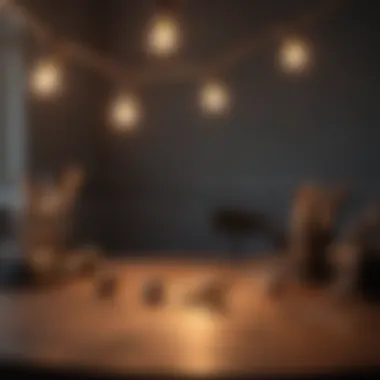

Equipping yourself with the right tools ensures the installation runs smoothly. Here’s a rundown of the essentials:
- Drill: A power drill is indispensable for creating anchor points. Look for one with various drill bits for versatility.
- Screwdrivers: Both Phillips and flat-head screwdrivers will be necessary for securing any mountings you use.
- Wire Cutters/Strippers: These are key for trimming your wire to the right length and exposing the ends for connections.
- Measuring Tape: Precision is vital. A measuring tape helps you plan where the lights will go, preventing missteps.
- Ladder: If you’re hanging lights high up, a sturdy ladder ensures you can reach your intended spots safely.
These tools create a smoother experience, allowing you to focus on the aesthetic appeal of your installation.
Safety Gear Recommendations
Safety shouldn't be an afterthought; it should come first. Here’s what to keep in mind:
- Gloves: Protect your hands while handling tools, wires, and lights. Thicker gloves can prevent cuts and scrapes.
- Safety Glasses: Flying debris can be a hazard when drilling; protect your eyes with a sturdy pair of safety goggles.
- Hard Hat: If you’re working in a precarious area or using a tall ladder, a hard hat can protect against any unintended bumps.
- Non-slip Shoes: Make sure to wear shoes that have good grip to avoid slips while standing on ladders or uneven surfaces.
Ultimately, these safety measures are not just precautions; they’re essential for a successful, stress-free installation. Take your time to gather all necessary tools and materials before starting your project—it’ll save you from any last-minute scrambles and mishaps.
Installation Techniques
When it comes to hanging string lights, the installation techniques you choose play a crucial role in achieving the desired effect. It’s not just about throwing up some lights and calling it a day; the approach you take influences everything from safety to visual appeal. A well-planned installation not only enhances your space but also minimizes potential hazards. Remember, safety and aesthetics can go hand in hand.
Mounting Methods for Different Environments
Outdoor Installations
Outdoor installations often require durability and weather resistance. One particular aspect that stands out here is the need for robust mounting methods that can handle varying weather conditions and potential physical impacts. People love to use string lights outside because they instantly elevate the mood of a garden party or a cozy evening on the patio.
The key characteristic of outdoor installations is that they are designed to withstand the elements. You’ll find that many DIY enthusiasts prefer options like sturdy hooks or poles anchored into the ground. This approach not only ensures safety but also adds an artistic dimension to your landscaping.
Unique features of outdoor string light setups include the use of weather-resistant bulbs that can endure rain or sleet. However, the main disadvantage might be the time and effort required in the setup. You often need to scout for the best mounting points and may have to deal with electrical considerations like grounding, which can throw a wrench in your plans.
Indoor Installations
Indoor installations present a different set of challenges and opportunities. Such environments allow for more creativity since there are no weather concerns. Here, the focus shifts primarily to enhancing the indoor ambience. Indoor string lights can transform a bland room into an inviting space through smart layouts and designs.
The key characteristic that makes indoor installations appealing is their versatility. One can string them along walls, wrap them around furniture, or hang them from ceilings to create a sparkling effect. A unique feature of indoor setups is the wide variety of lighting options available—ranging from soft white lights for a warm glow to colorful fairy lights for a festive ambiance.
However, the disadvantage is that depending on your layout, you might need to hide extension cords and ensure the lights don't become a tripping hazard. It’s also essential to check the compatibility of the lights with your indoor electrical systems to avoid any mishaps.
Securing the Wire
Securing the wire properly is not just about making sure the lights stay put; it has significant implications for safety and visual neatness. Properly secured wires ensure they don’t sag or hang loose, which can be both an eyesore and a hazard. Numerous methods can help achieve a tight and professional look. For example, using cable ties or hooks can pull the wire taught without damaging the surface they’re affixed to.
One effective technique to secure wires is the "zip tie" method. You can fasten the wire along a surface like a beam or a fence post. This is effective as it keeps the wire aligned while preventing it from swaying with the wind or other forces.
Connecting the Lights with the Power Source
This step sounds straightforward, but it deserves careful consideration. Connecting the lights to the power source involves ensuring all connections are firm and that you're using outlets capable of handling the load the lights will demand. An improper connection can lead to outages or worse, fire hazards.
To set up a safe connection, use an outdoor extension cord rated for where you plan to install them, especially in outdoor settings. This prevents overheating and ensures they won’t be easily damaged by external elements. Always check that the circuit you're using can handle the additional load before plugging in.
In summary, installing string lights is more than just aesthetics; it's a balance of style, safety, and functionality. Each decision made during installation has its own set of pros and cons, so understanding these intricacies will set you up for success in achieving the atmosphere you desire.
Aesthetic Considerations
When it comes to illuminating a space, the aesthetic considerations play a pivotal role. It’s not just about adding light to the darkness but rather curating a visual experience that speaks to the style and ambiance of a setting. String lights, with their myriad design possibilities, serve as both functional and decorative elements. This dual role is essential, especially in outdoor spaces where the mood can shift from festive to tranquil with just a flick of a switch.
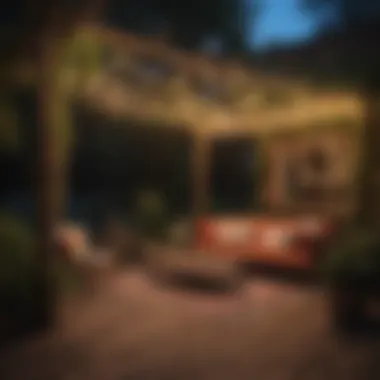

Elements and Benefits of Aesthetics
In any lighting project, understanding the color and brightness choices becomes crucial. Lights can evoke different emotions and set various moods, manipulating how a space is perceived. Think of soft yellow lights that wrap around your garden, giving it a warm, inviting glow, versus bright white lights that can make the same area feel sterile and cold. Here, the color temperature and luminosity work hand in hand.
Consider how ambient light can soften harsh architectural angles or bring attention to beautiful garden features. A thoughtfully planned arrangement can enhance these aspects—allowing homeowners to express their personal style while creating an inviting atmosphere for guests.
"Light itself is a medium of creativity; it vibes with the space, creating an ambiance that tells stories."
Beyond simple illumination, patterns and shapes formed by string lights contribute significantly to the aesthetic allure. A winding line of lights can look casual and playful, while geometric layouts might evoke a sense of elegance and chic sophistication. Therefore, as you ponder the arrangement of your string lights, ask yourself: what story do you want your space to tell?
Color and Brightness Choices
The spectrum of color available in string lights is vast, presenting countless opportunities to customize your environment. When choosing colors, consider the existing decor and the intended mood. For instance:
- Warm White: This soft hue creates an inviting and cozy atmosphere—ideal for a relaxed outdoor dinner.
- Cool White: Best for modern settings, promoting clarity and focus. It works well in more contemporary designs.
- Colored Bulbs: Reds, greens, and blues can turn your space into a visual treat. Perfect for parties or holiday celebrations, they can even be synced to themes or seasons.
Brightness is equally essential to get right. Too glaring, and you risk overwhelming the senses. Too dim, and your design might fade into obscurity. Test out different combinations to find the sweet spot that showcases your space without overwhelming it.
Creating Patterns and Shapes
Designing your string light arrangements is akin to painting with light. Patterns and shapes can drastically change how your space is experienced. Here are a few considerations when creating these visual elements:
- Linearity: Straight lines of lights can create a clean, structured look, perfect for modern or minimalist styles.
- Curved Lines: Wavy forms add a touch of whimsy and can soften rigid spaces, making them feel more inviting.
- Layering: By overlapping strings at varying heights, you create depth and intrigue, drawing the eye naturally into the space.
Maintenance and Safety Protocols
When it comes to hanging string lights, ensuring their longevity and safe operation is non-negotiable. Like a well-tended garden, proper maintenance keeps your lights blooming bright without any unwelcome surprises down the line. Inadequate attention can lead to damage or hazards, which often leaves you in a lurch when it matters most. This section unpacks essential maintenance habits and safety protocols to help you enjoy your light display worry-free.
Regular Inspection Tips
Frequent inspections are crucial in maintaining the safety and aesthetic appeal of your string lights. Consider these handy tips:
- Visual Examination: Every month, give your lights a thorough look. Keep an eye out for frayed wires, flickering bulbs, or any signs of moisture seepage.
- Socket Checks: Inspect the sockets for any corrosion or debris. Make sure they are clean and securely hold each bulb in place.
- Connections: Ensure all connections are tight and there are no loose wires. This can prevent short circuits or flickering effects.
- Weather Consideration: After a storm or harsh weather, double-check the installation. Wet conditions can expose weaknesses, leading to issues later on.
- Lifespan Awareness: Most bulbs have a predicted lifespan, often stated on the packaging. Keep track of when you installed your lights and replace them as necessary to avoid unexpected outages.
Troubleshooting Common Issues
Every now and then, you might run into a hiccup with your string lights. Here’s how to tackle some frequent concerns:
- Lights Won't Turn On: First, check if the power source is functioning. Plug something else in to rule out a malfunction. If the power is fine, inspect for blown fuses or burned-out bulbs. Sometimes, a simple bulb change is all it takes.
- Flickering Bulbs: This can often be traced back to loose bulbs or poor connections. Try tightening the bulbs or re-secure the wires. If the problem persists, consider replacing the affected bulbs.
- Damaged Wires: If you notice chew marks, that could be a sign of pests. Cover exposed wires with electrical tape or replace them entirely to avoid fire hazards.
- Water Infiltration: Dissolve any concerns of short-circuiting by keeping wires elevated and dry. Use weatherproof covers and ensure any connectors are outdoor-rated.
"Keeping a watchful eye on your string lights not only enhances safety but also elevates your overall lighting experience!"
Maintaining string lights can appear daunting at first, yet it’s a simple process that can save you time and money in the long run. By implementing consistent inspection and addressing issues promptly, you will ensure a bright and inviting atmosphere for years to come.
Epilogue
The conclusion serves as the bookend to our exploration of string lighting. It's not just about tying everything together; it's about underscoring the significance of thoughtful installation and design when it comes to lighting your space effectively.
Recap of Key Points
Reflecting on the journey through this article, several key aspects stand out:
- Understanding String Lights: String lights are versatile. They can change the entire mood of your space, whether it's an indoor setting or outdoors under the stars.
- Planning Your Installation: Careful planning is necessary. From selecting the right location to determining the number of lights you need, preparation makes the process smoother.
- Tools and Materials: Having the right tools is half the battle. Using the appropriate wire and safety gear ensures not only ease of installation but also safety in the long run.
- Installation Techniques: Knowing how to mount and secure your lights correctly prevents future issues, such as sagging or accidental disconnections.
- Aesthetic Considerations: The way you arrange your lights can set the mood, define your space, and enhance the aesthetic appeal of your home.
- Maintenance and Safety Protocols: Regular inspections for wear and tear can extend the lifespan of your lights and keep your setup safe.
The Transformative Impact of Proper Lighting
Well-placed string lights do more than just illuminate; they create ambiance and can adjust perceptions of space. The soft glow of string lights can transform a simple backyard into a cozy gathering spot or turn an ordinary room into a haven of relaxation.
Essential benefits include:
- Mood Enhancement: Proper lighting changes the atmosphere, making it inviting and enjoyable, especially for gatherings or peaceful evenings.
- Functional Spaces: Good lighting helps define areas for different activities, like dining or lounging.
- Aesthetic Appeal: Beautifully arranged lights can serve as decor, adding charm and character to your setting.
- Safety and Security: Well-lit areas create a sense of safety, discouraging unwanted visitors while making pathways clear and accessible.
In summary, while string lighting may seem like a small detail, it can have a profound impact on how we experience our spaces. Paying attention to installation, design, and maintenance can lead to an enjoyable and safe lighting experience that transforms an ordinary environment into something truly special.
